Motorola DP3441e Portable Digital Two Way Radio
12 Months Manufacturers
Warranty - For the radio only
What you get
- Battery (PMNN4440AR)
- Antenna
- 3" Belt Clip
26 % Off - Save a total of £186.95 (Incl. Vat)
12 Months Manufacturers
Warranty - For the radio only
What you get
- Battery (PMNN4440AR)
- Antenna
- 3" Belt Clip
Key updated features include
- Integrated accelerometer for optional Man Down
- Bluetooth® 4.0
- Indoor location tracking
- Multi-constellation GNSS for increased location accuracy
- Integrated Wi-Fi®
- Over-the-air software updates
- Enhanced audio quality
- Improved expandability
- Better range (up to 8%)
- Better waterproofing (IP68)
The next generation of professional two radios introducing the all new DP3441e radio, offering the latest in technology and design with all new features including improved memory , waterproofing (IP68) and Bluetooth® 4.0 connectability for commutation without wires. Delivering comprehensive connectivity to your organisation.
With integrated Wi-Fi enabling remote software updates allowing more efficient operation and reduce downtime also having both indoor and outdoor allows location-tracking capabilities give you total visibility of your resources.
Meeting military standards 810 C, 810 D, 810 E, 810 F, 810 G the DP3441e offers a robust and compact design to meet any professional working environment needs,

Features:
- Non-display model
- 32 channels
- VHF (136-174 MHz) and wideband UHF (403-527 MHz)
- Integrated GPS and Bluetooth® audio & data
- Intelligent Audio automatically adjusts volume to compensate for background noise
- Increased background noise suppression helps filter out unwanted external clamour
- Analogue and digital modes for ease of migration
- Customizable Voice Announcement provides audible confirmation of actions
- Quick release accessory connector (no tools required to connect accessories)
- Supports 5-tone analogue signalling
- Basic and enhanced privacy for improved security
- IMPRES audio accessories for improved performance
- Supports Transmit Interrupt suite to prioritise critical communications
- Pre-programmed text messaging
- IP Site Connect, Capacity Plus and Linked Capacity Plus
- Interchangeable colour bands on antenna for easy identification
- Two programmable buttons plus dedicated orange emergency button
| SKU | DP3441e |
|---|---|
| Weight | 0.254000 |
| Radio Type | Portable Radio |
| IP Rating | IP68 |
| Display | N |
| Standard Battery Life | 16 hrs Digital / 12 hrs Analogue |
| Power Output | 4W UHF / 5W VHF |
| Lone Worker | Y |
| Man Down | Optional |
| GPS / Bluetooth | Y |
| Dimensions | 100 x 55 x 30 mm |
| Programmable Buttons | 2 |
| Battery type | Nimh or Li-ion |
| Emergency Alarm | Y |
| Warranty | Select Warranty |
| Has Bundles | No |

















